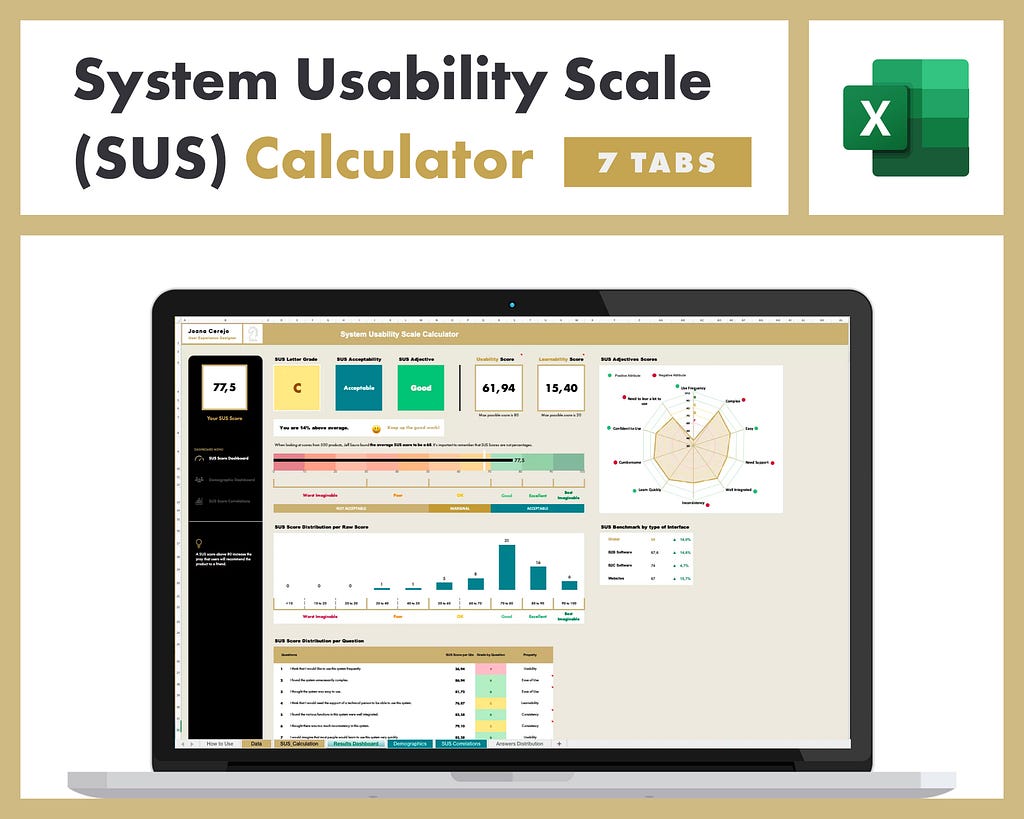UX Measurement: The Ultimate Guide to the System Usability Scale (SUS)
This article demystifies user experience (UX) metrics by simplifying the application of the System Usability Scale (SUS) for everyday professionals, with a particular focus on empowering UX designers. By breaking down statistical jargon, it aims to make measuring user experiences more accessible and efficient.
Are you tired of feeling lost in the world of UX metrics? Do you find yourself struggling to decipher complex statistical jargon and efficient data analysis? If so, you’re not alone. I also felt the same when I started to gain more interest in UX analytics and quantitative UX research, I understand the frustration.
Because I felt like that, I now recognize the importance of providing accessible and practical resources for any individual, designer or non-designer, interested in user experience. Especially, because in today’s digital landscape, UX has become an essential factor in determining the success or failure of a product or service. So, we have to be more analytic and data-driven than ever before.
Quantifying experiences involves using UX metrics, which are quantitative user experience measurements.
UX metrics can help businesses identify areas of improvement, track changes over time, and compare the user experience of various products or features. Businesses can use these metrics to better understand how users interact with their products and make informed decisions.
Where to Start?
In today’s digital landscape, UX has emerged as a pivotal factor that can make or break a business’s success. While many stakeholders may recognize the importance of design in theory, it’s often challenging to quantify its impact on the bottom line. This is where UX metrics play a crucial role in bridging the gap between design efforts and tangible business outcomes. By effectively leveraging UX metrics, businesses can not only secure buy-in from key stakeholders but also elevate awareness of the substantial business value that design brings to the table.
The Power of SUS: Simplifying UX Measurement
Many everyday individuals, including UX designers, face challenges when it comes to measuring user experiences effectively. That’s why I’ve created this article, with a special focus on the System Usability Scale (SUS), to simplify the process for everyone.
The SUS is a powerful tool for measuring the usability of a system, software, applications, or even services but its complexity can often be overwhelming. Much of the content available online is either too shallow or too complex, leaving many individuals, including UX designers, feeling overwhelmed. Therefore, I have created the most complete and comprehensive SUS course to simplify its analysis and make it accessible to everyone, regardless of their statistical or research knowledge.
Advanced Techniques for Measuring System Usability Scale (SUS) Course

This complete course offers a comprehensive journey into the world of the System Usability Scale (SUS) and UX metrics. I start the course by delivering a thorough understanding of UX metrics, with a particular focus on the SUS. You will grasp the significance of measuring user experience, become familiar with the basics of UX metrics, and learn how to seamlessly integrate user experience measures into agile development processes.
- Module 1 | Get acquainted with the course structure and objectives. Learn why measuring user experience matters and explore the key moments for conducting an SUS study. Understand the difference between measure, measurement, and metrics in UX.
- Module 2 | Delve into the origins of SUS and understand its significance in UX measurement. Learn about SUS components, scoring methodology, and how to determine the right sample size for a study.
- Module 3 | Gain practical insights into setting up and administering a SUS survey effectively. Learn to define the right sample size and create a study hypothesis. Engage in hands-on exercises for administering SUS surveys.
- Module 4 | Learn to build a powerful SUS calculator to unlock the potential of your SUS data with Excel and establish a robust data repository. You will master computing SUS scores by participant and question, and bulletproof your data analysis to manage missing values and detect outliers.
- Module 5 | Learn to create a SUS Dashboard for advanced data analysis and visualization. Explore techniques for correlating SUS scores with demographic data and identifying areas for improvement. Recap key learnings and encourage continued application of SUS metrics principles.
I will provide you with practical tips on how to administer the SUS questionnaire and establish a data repository for interpreting the results. You’ll learn how to analyze SUS scores and understand their implications for the usability of your product or service. No more confusing explanations like:
To calculate the SUS Score, you simply subtract 1 from the participant’s response for odd-numbered questions and subtract the participant’s score from 5 for even-numbered questions. Then, you multiply the sum by 2.5 to get your final SUS Score!
What if a participant forgets or chooses not to answer one or more questions? Or what if a participant rushes through the questionnaire without noticing the intentional alternating pattern of positive and negative questions? And don’t forget about determining the right number of participants for your study!
Many SUS articles and guides overlook important factors like missing values, outliers, and sample size. The ones that do discuss these topics often use complex statistical language that can be difficult for those without a statistical or quantitative research background to understand.
That is why I have built this course! But that’s not all — I’ll also explore common pitfalls and misconceptions surrounding the SUS, helping you avoid common pitfalls and make the most of this valuable tool. By the end of this course, you’ll feel confident navigating the SUS maze and using UX metrics to drive meaningful improvements in your work.
If you’re curious about what you’ll learn in this course, take a look at my SUS calculator because that’s what we’ll aim to recreate together.

In sum, this course provides you with a robust framework to measure and evaluate the usability of any digital solution, enabling you to identify areas for improvement and create intuitive interfaces that captivate your users and enable business growth. You will make informed decisions based on comprehensive usability metrics. Uncover hidden pain points, identify usability bottlenecks, and guide your team toward creating remarkable digital products that resonate with your target audience.
So, if you’re ready to simplify UX metrics and take your research to the next level, join me as we navigate the System Usability Scale maze together.
Navigating the System Usability Scale (SUS) Maze was originally published in UX Planet on Medium, where people are continuing the conversation by highlighting and responding to this story.